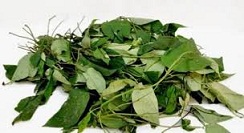Nutrition and Difference between Okazi, Uziza, & Utazi leaves
Nutrition is the science that interprets the nutrients and other substances in food concerning maintenance, growth, reproduction, health, and disease of an organism.
It includes food intake, absorption, assimilation, biosynthesis, catabolism and excretion. Wikipedia
Based On These Facts, the Nutrition and Difference between Okazi, Utazi, & Uziza Leaves Include;

Okazi/Ukazi/Afang Leaf (Gnetum africanum, eru or African jointfir) is a vine gymnosperm species found natively throughout tropical Africa.
Gnetum africanum is traditionally a wild vine and is considered to be a wild vegetable.
The leaves are tough (hard) and glossy and look more like the leaves of an orange tree.
This greenish climbing plant is prevalent in tropical regions especially Nigeria, Congo, Gabon, Angola, Asia, and South America.
Both the seeds and leaves of this plant are edible.
The two main species found in Africa are Gnetum buchholzianum and Gnetum Africanum.
The okazi vine is a non-seasonal perennial plant that can grow as new shoots from the section where the stem has been cut out or as a rhizome.
It does not have a distinctive smell, but it has a slightly bitter taste. Some people add it to egusi soup and other vegetable soups or chew it with palm oil.
Okazi, eru or afang vine usually produces tiny flowers on maturity and the seeds have a resemblance with a drupe fruit, which is approximately 4–8 mm × 10–15 mm in size.
The edible leaves are very hard and are usually thinly sliced; the leaves are used for different cuisines and recipes ranging from stew and soups.
In Nigeria for example, you will usually see it in local markets.
Use it in Afang Soup (grind the sliced leaves before using it in Afang Soup).
Add the thinly sliced leaves when cooking egusi to get Okazi Soup that is common in Imo & Abia states.
What Is The Nutrition And Health Benefit Of Okazi Leaf?
The okazi has characteristics thick papery-like leaves which are usually hard to cut.
Due to the antioxidant, anti-inflammatory and anticarcinogenic properties of Gnetum Africanum, the leaf can be used as a remedy for certain ailments and diseases.
The health benefits also include the treatment of enlarged spleens, sore throats, and nausea.
Ukazi also eases constipation and helps to control blood sugar levels in people with diabetes.
Uziza Leaves (False Cubeb Leaves)

Piper guineense – Uziza is an African Plant of which two parts are used: leaves and the seed. It is called Uziza in Igbo and Ata iyere in Yoruba.
The glossy leaves which have a slightly peppery taste are green when fresh and darker green when dried or ground.
Uziza is a popular local spice mainly used in Nigerian dishes. The spice has nutritional, culinary, medicinal value and insecticidal value.
The presence of phytochemicals in Piper guineese shows that it has therapeutic properties.
These spices are said to be therapeutically useful in the management of convulsion, leprosy, stomachache, inflammation and/or rheumatoid pains, cough, and loss of appetite (Valko et al, 2007).
The leaves, whether whole or ground, are used in soups. They are added to soups at the end of cooking, in the last 5 minutes.
It is mostly used with uda for cooking Pepper soup, Gi Nmiri Oku (yam pepper soup) especially for new moms after pregnancy, uziza leaf soup, and Oha/Ora soup.
Some people add it to Egusi Soup too. The fresh leaves are usually washed and shredded before use.
The uziza seed (false cubeb pepper/black peppercorns) is ”hot” and can still be used to get the ”Uziza taste” in the absence of the leaves.
The Wonders of Uziza Leaf
Uziza leaves are aseptic and can relieve flatulence.
It contains alkaloids, which are one of the most therapeutically efficient significant bio active substances in plants. Uziza helps with the treatment of infertility in women and low sperm count in men
Nutrition and Health Benefits of Piper Guineese (Uziza Seed)
The seed is used to treats intestinal disorders like indigestion, flatulence, dysentery, diarrhea, and cholera.
Utazi /Otazi Leaves (Gongronema Latifolium) are heart-shaped leaves that have the characteristic slightly bitter-sweet taste, especially when you eat it fresh.

It belongs to the Asclepiadaceae family of plants and is widespread in tropical countries in the West African region.
Most of Utazi leaves can be found in the south of Nigeria. and have different names in every tribe in Nigeria.
The Igbo tribe calls it Utazi, but in the Yoruba language, it is called Arokeke. The Efik and Ibibio tribes name these leaves Utasi.
Usually, all parts of this plant, including seeds and roots. are edible
Gangronema latifolium (Utazi) are local leaves, which are widely used in Nigerian dishes. It is slightly bitter and has culinary, medicinal, and nutritional values.
It is mostly used as a garnish for food like African salad (Abacha & Ugba), Nkwobi and Isiewu but most especially for soups like Utazi and Nsala soup and unripe plantain recipe good for diabetic patients.
The high amount of minerals and presence of phytochemicals also give Utazi leaves some of its therapeutic properties.
Utazi and Fertility
A recent scientific study showed that using Utazi leaves in nutrition helped to increase the effectiveness of reproductive hormones and help to raise low sperm count.
Women with infertility problems should boil Utazi leaves with some lime juice, honey and drink one glass of it daily during their period days




Pingback: Okazi Soup: Nigerian Okazi Soup Recipe | Igbo Ofe Ukazi - 9jafoods